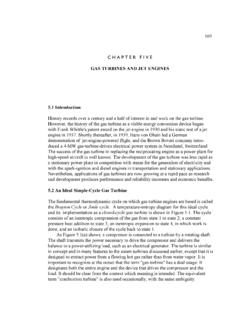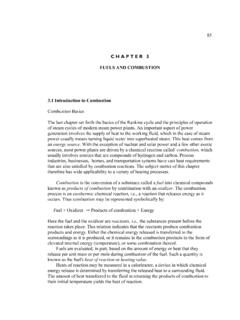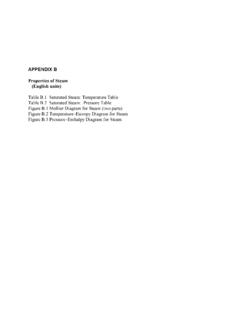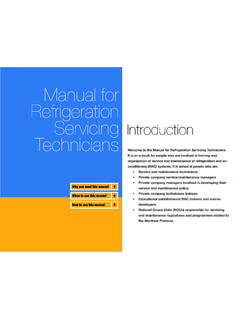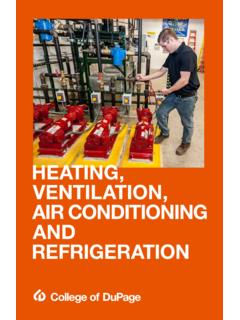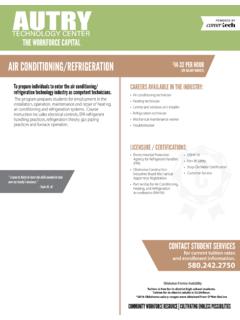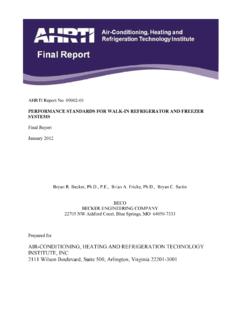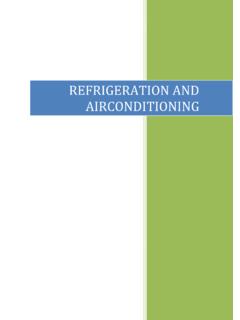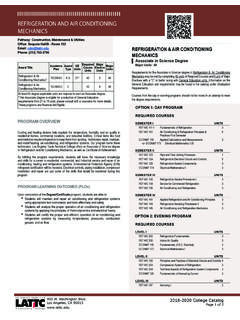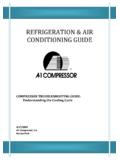Transcription of REFRIGERATION AND AIR CONDITIONING
1 282C H A P T E R 8 REFRIGERATION AND AIR IntroductionUp to this point we have considered fossil-fueled heat engines that are currently in use. Thesedevices have provided society's answers to the thermodynamic question: How can the chemicalenergy of fossil fuels be converted into mechanical work and motive power? Let us now turn ourattention to the another great thermodynamic question: How can thermal energy be transferredfrom cold to warmer regions?The well-known Clausius statement of the Second Law of Thermodynamics asserts: It isimpossible to construct a device that, operating in a cycle, has no effect other than the transferof heat from a cooler to a hotter body.
2 Thus the Clausius statement tells us that energy (heat) willnot flow from cold to hot regions without outside assistance. The devices that provide this helpare called REFRIGERATION units and heat pumps. Both types of devices satisfy the Clausiusrequirement of external action through the application of mechanical power or natural transfers ofheat (more on this later).The distinction between refrigerator and heat pump is one of purpose more than REFRIGERATION unit transfers energy (heat) from cold to hot regions for the purpose of coolingthe cold region while the heat pump does the same thing with the intent of heating the hot following will focus on REFRIGERATION and make the distinction between REFRIGERATION and heatpumps only when it is essential to the should be pointed out that any heat engine cycle, when reversed, becomes a refrigerationcycle, becuase the cyclic integral of the heat transfer, and thus the net work, becomes implies heat rejection at higher than the lowest cycle temperature.
3 The vapor compression REFRIGERATION system is the mainstay of the REFRIGERATION and airconditioning industry. Absorption REFRIGERATION provides an alternative to the vapor compressionapproach, particularly in applications where a heat source is economical and readily available. Thischapter considers both of these system types in turn, and closes with a discussion of moist airbehavior and its influence on air CONDITIONING system other specialized REFRIGERATION systems exist. As just stated, in principle any heatengine cycle, when reversed, becomes a REFRIGERATION cycle. Such cycles are usually discussed inthermodynamics texts.
4 Other systems that are occasionally used in special applications includethermoelectric coolers, which employ electrical work, and Hilsch or vortex tubes, which employcompressed gas as an energy Vapor Compression RefrigerationConsider an insulated cold region of temperature TL as shown in Figure Heat leakage fromthe surroundings to the system tends to increase the system s temperature. In order to keep thecold region at temperature TL, the conservation of energy requires the removal of an amount ofheat equal to the energy inflow. This is done by a cold region heat exchanger that has an evencolder liquid flowing through it to carry away the heat.
5 If the fluid is a saturated liquid, it willevaporate and absorb energy from the cold region in its heat of vaporization. Such a heatexchanger is called an evaporator. Thus the basic problem of REFRIGERATION may be reduced to one284of providing a mechanism to supply cool saturated liquid or a mixture of liquid and vapor, therefrigerant, to an evaporator. Vapor compression REFRIGERATION , as the name suggests, employs a compression process toraise the pressure of a refrigerant vapor flowing from an evaporator at pressure p1 to p2, as shownin Figure The refrigerant then flows through a heat exchanger called a condenser at the highpressure, p2 = p3, through a throttling device, and back to the low pressure, p1, in the pressures p2 = p3 and p4 = p1 correspond to refrigerant saturation temperatures, T3 and T1 =T4, respectively.
6 These temperatures allow natural heat exchange with adjacent hot and coldregions from high temperature to low. That is, T1 is less than TL; so that heat, QL, will flow fromthe cold region into the evaporator to vaporize the working fluid. Similarly, the temperature T3allows heat, QH, to be transferred from the working fluid in the condenser to the hot region at is indicated by the arrows of Figure the resulting device is one in which heat is transferred from a low temperature, TL, to ahigh temperature, TH, using a compressor that receives work from the surroundings, thereinsatisfying the Clausius throttling device, as shown in Figure , restrains the flow of refrigerant from thecondenser to the evaporator.
7 Its primary purpose is to provide the flow resistance necessary tomaintain the pressure difference between the two heat exchangers. It also serves to control therate of flow from condenser to evaporator. The throttling device may be a thermostatic expansionvalve (TEV) controlled by evaporator exit temperature or a long, fine-bore pipe called a an adiabatic throttling device, the First Law of Thermodynamics requires that h3 = h4 forthe irreversible process, because Q and W are zero and kinetic energy change is negligible. Thussaturated liquid at T3 flashes to a mixture of liquid and vapor at the evaporator inlet at theenthalpy h4 = h3 and pressure p4 = p1.
8 Also the evaporator entrance has the quality x4 andtemperature T4 = T1. Heat from the cold source at TL > T4 boils the mixture in the evaporator to asaturated or slightly superheated vapor that passes to the suction side of the compressor in small and medium-sized REFRIGERATION units is usually a reciprocating orother positive-displacement type, but centrifugal compressors often are used in large systemsdesigned for commercial and industrial may be noted from the T-s diagram in Figure that the vapor compression cycle is areversed Rankine cycle, except that the pressure drop occurs through a throttling device ratherthan a turbine.
9 In principle, a turbine or expansion device of some kind could be used tosimultaneously lower the refrigerant pressure and produce work to reduce the net work requiredto operate the compressor. This is very unlikely because of the difficulty of deriving work from amixture of liquid and vapor and because of the low cost and simplicity of REFRIGERATION exploded view of a through-the-wall type room air conditioner commonly used in motelsand businesses is shown in Figure A fan coil unit on the space side is the evaporator. Athermally insulating barrier separates a hermetically sealed, electric-motor-driven positivedisplacement compressor unit and a finned-tube heat exchanger condenser from the room on theoutdoor shows a packaged air- CONDITIONING unit designed for in-space use or for a nearbyspace with short duct runs.
10 Units sometimes are designed to operate with either one or twocompressors, coils, and fans to better accommodate varying cooling demands. A unit with water-cooled condensers such as that shown requires an external heat sink, usually provided by a nearbyground-level or rooftop evaporative cooling tower. Rather than being combined in a single enclosure, REFRIGERATION units frequently are installedas split systems. Figure shows an uncovered rooftop condensing unit that contains acompressor and air cooled condenser. Such units are, of course, covered to resist the outdoorenvironment over many years. Cooled refrigerant is piped in a closed circuit to remote airdistribution units that contain cooling coils (evaporators) and throttling devices.
